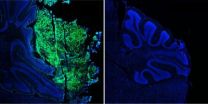Being neurotic, and conscientious, a good combo for health
2012-11-14
(Press-News.org) Under certain circumstances neuroticism can be good for your health, according to a University of Rochester Medical Center study showing that some self-described neurotics also tended to have the lowest levels of Interleukin 6 (IL-6), a biomarker for inflammation and chronic disease.
Researchers made the preliminary discovery while conducting research into how psychosocial factors such as personality traits influence underlying biology, to predict harmful conditions like inflammation.
Known as one of the "Big 5" traits, neuroticism is usually marked by being moody, nervous, and a worrier, and linked to hostility, depression, and excessive drinking and smoking. The scientific literature is rife with findings that extreme anxiety and self-medicating with alcohol and other substances due to neuroticism are detrimental to long-term health. The other four traits are openness (creative, curious, broad-minded), extraversion (outgoing, friendly, talkative), agreeableness (helpful, warm, sympathetic), and conscientiousness (organized, responsible, hardworking).
Nicholas A. Turiano, Ph.D., a post-doctoral fellow in the URMC Department of Psychiatry, wondered about a gray area – those people with average-to-high levels of neuroticism who are also conscientious. Exhibiting higher levels of conscientiousness as well as neuroticism points to folks who tend to be high-functioning in society, very organized, goal-oriented, planners, and more likely to be reflective.
"These people are likely to weigh the consequences of their actions, and therefore their level of neuroticism coupled with conscientiousness probably stops them from engaging in risky behaviors," said Turiano, whose study is published online by the journal Brain, Behavior, and Immunity.
Turiano and co-authors sought an objective way to test their hypothesis that "healthy neuroticism" could be protective. They tapped into the National Survey of Midlife Development in the U.S. (MIDUS) database, a sampling of adults (1,054 participants) from the West Coast, East Coast, and Midwest. Participants took part in a full clinic-based health evaluation, including tests for disease-related biomarkers, physiological function, and personality traits.
Interleukin 6, an important immune protein, is easily measured by a fasting blood test. It was one of several pieces of data collected and available in the MIDUS database, because it provides an accurate assessment of conditions linked to inflammation such as heart disease, stroke, asthma, arthritis, diabetes, and some cancers.
Researchers studied many pathways between personality, health behaviors, and chronic disease, but the neuroticism-conscientiousness interaction emerged among 441 individuals who scored moderate to high on both traits. And, the higher a person scored in both conscientiousness and neuroticism, the lower their levels of IL-6. This group also had lower body-mass index scores and fewer diagnosed chronic health conditions, results showed.
The term "healthy neuroticism" was coined in 2000 when other researchers first described how conscientiousness may provide the dose of self-discipline that reduces unhealthy neurotic behaviors like overeating, smoking, and drinking too much alcohol – all of which have direct or indirect consequences for inflammation. In contrast, a neurotic person who scores low in conscientiousness may not have healthy avenues to deal with stress, the paper said.
"Speculation is that healthy neurotics may be hyper-vigilant about their lifestyle and about seeking treatment when a problem arises," Turiano said. "It's their conscientiousness that guides their decisions to prevent disease or quickly get treatment when they don't feel well."
However, Turiano cautions that more research is needed before scientists can draw firm conclusions. Simply labeling certain traits as "good" versus "bad" as they relate to health is not sufficient for a full understanding of the personality-health link.
"Future studies will try to figure out who are the healthy neurotics and why they are healthier," Turiano said. "Eventually, the clinical application might allow us to identify patients at high risk for chronic inflammation, and therefore have an increased risk of health problems and death."
###
Grants from the National Institute of Mental Health and the National Institute of Aging funded the study. URMC co-authors include Turiano's mentor, Ben Chapman, Ph.D., M.P.H., assistant professor of Psychiatry; and Jan Moynihan, Ph.D., the Engel Professor of Psychosocial Medicine, Department of Psychiatry, and principal investigator at the Rochester Center for Mind-Body Research. END
ELSE PRESS RELEASES FROM THIS DATE:
Research strengthens link between obesity and dental health in homeless children
2012-11-14
Obesity and dental cavities increase and become epidemic as children living below the poverty level age, according to nurse researchers from the Case Western Reserve University and the University of Akron.
"It's the leading cause of chronic infections in children," said Marguerite DiMarco, associate professor at the Frances Payne Bolton School of Nursing at Case Western Reserve University.
Researchers Sheau-Huey Chiu, assistant professor, and graduate assistant Jessica L. Prokp, from the University of Akron's College of Nursing, contributed to the study.
Researchers ...
For brain tumors, origins matter
2012-11-14
Cancers arise when a normal cell acquires a mutation in a gene that regulates cellular growth or survival. But the particular cell this mutation happens in—the cell of origin—can have an enormous impact on the behavior of the tumor, and on the strategies used to treat it.
Robert Wechsler-Reya, Ph.D., professor and program director at Sanford-Burnham Medical Research Institute, and his team study medulloblastoma, the most common malignant brain cancer in children. A few years ago, they made an important discovery: medulloblastoma can originate from one of two cell types: ...
Stem cell finding could advance immunotherapy for lung cancer
2012-11-14
CINCINNATI—A University of Cincinnati (UC) Cancer Institute lung cancer research team reports that lung cancer stem cells can be isolated—and then grown—in a preclinical model, offering a new avenue for investigating immunotherapy treatment options that specifically target stem cells.
John C. Morris, MD, and his colleagues report their findings in the Nov. 13, 2012, issue of PLOS One, a peer-reviewed online publication that features original research from all disciplines within science and medicine.
Stem cells are unique cells that can divide and differentiate into ...
New type of bacterial protection found within cells
2012-11-14
Irvine, Calif., Nov. 13, 2012 — UC Irvine biologists have discovered that fats within cells store a class of proteins with potent antibacterial activity, revealing a previously unknown type of immune system response that targets and kills bacterial infections.
Steven Gross, UCI professor of developmental & cell biology, and colleagues identified this novel intercellular role of histone proteins in fruit flies, and it could herald a new approach to fighting bacterial growth within cells. The study appears today in eLife, a new peer-reviewed, open-access journal supported ...
Uranium exposure linked to increased lupus rate
2012-11-14
CINCINNATI—People living near a former uranium ore processing facility in Ohio are experiencing a higher than average rate of lupus, according a new study conducted by scientists at the University of Cincinnati and Cincinnati Children's Hospital Medical Center.
Lupus is a chronic inflammatory disease that can affect the skin, joints, kidneys, lungs, nervous system and other organs of the body. The underlying causes of lupus are unknown, but it is usually more common in women of child-bearing age.
For this new study, a collaborative team of UC and Cincinnati Children's ...
Less of a shock
2012-11-14
Implantable defibrillators currently on the market apply between 600 and 900 volts to the heart, almost 10 times the voltage from an electric outlet, says Ajit H. Janardhan, MD, PhD, a cardiac electrophysiology fellow at the Washington University's School of Medicine.
After being shocked, he says, some patients get post-traumatic stress disorder. Patients may even go so far as to ask their physicians to remove the defibrillator, even though they understand that the device has saved their lives.
The huge shocks are not only unbearably painful, they damage the heart muscle ...
The road to language learning is iconic
2012-11-14
Languages are highly complex systems and yet most children seem to acquire language easily, even in the absence of formal instruction. New research on young children's use of British Sign Language (BSL) sheds light on one of the mechanisms - iconicity - that may endow children with this amazing ability.
For spoken and written language, the arbitrary relationship between a word's form – how it sounds or how it looks on paper – and its meaning is a particularly challenging feature of language acquisition. But one of the first things people notice about sign languages is ...
State of Nuevo León first to benefit from improved nationwide air quality information system
2012-11-14
This press release is available in Spanish and French.
Monterrey, 13 November 2012—Today, the Nuevo León state ministry of sustainable development, with support from the Commission for Environmental Cooperation (CEC), launched a revamped air quality information management system in Monterrey, Mexico, using AirNow-International.
This CEC initiative, developed in coordination with Canadian, Mexican and US government agencies, is laying the foundation for improved ways to inform citizens around the country about air quality in their communities with real-time data that ...
NASA sees sun emit a mid-level flare
2012-11-14
On Nov. 13, 2012, the sun emitted a mid-level solar flare, peaking at 9:04 p.m. EST.
Solar flares are powerful bursts of radiation. Harmful radiation from a flare cannot pass through Earth's atmosphere to physically affect humans on the ground, however -- when intense enough -- they can disturb the atmosphere in the layer where Global Positioning System (GPS) and communications signals travel. This disrupts the radio signals for as long as the flare is ongoing, anywhere from minutes to hours.
This flare is classified as an M6 flare. M-class flares are the weakest flares ...
Hinode to support ground-based eclipse observations
2012-11-14
On Nov. 13, 2012, certain parts of Earth will experience a total solar eclipse, which, like all eclipses, will only be visible when you are aligned in a straight line with the moon and the sun. In this case the eclipse will only be seen from a narrow corridor in the southern hemisphere that is mostly over the ocean but also cuts across the northern tip of Australia. The JAXA/NASA Hinode mission will experience a partial eclipse of the sun near the same time as the observers in Australia. Hinode will coordinate its observations with those from the ground, before, during, ...



